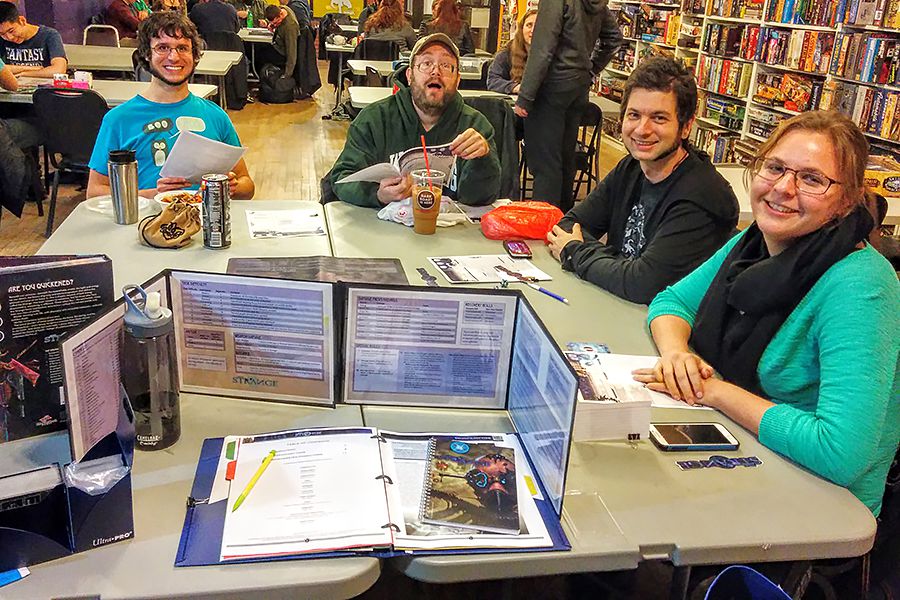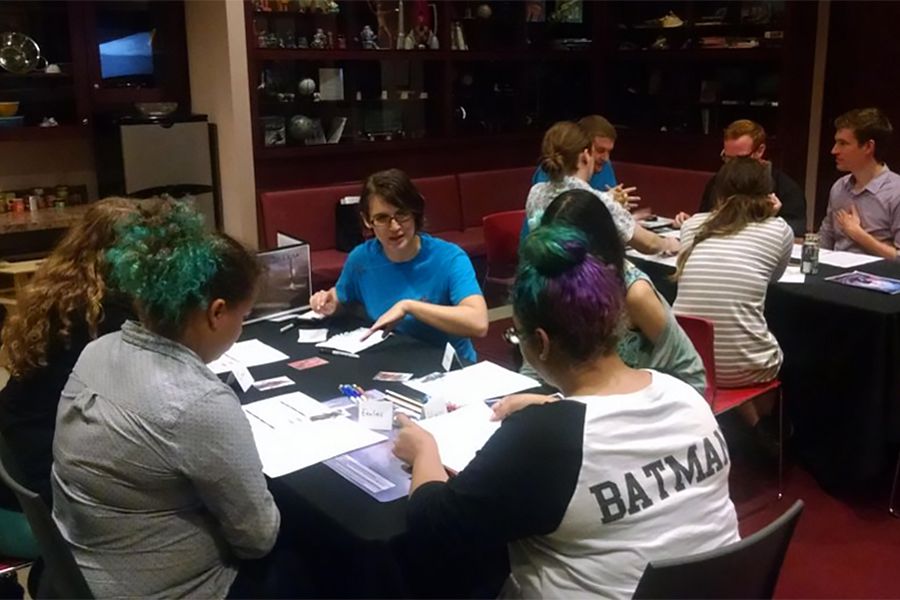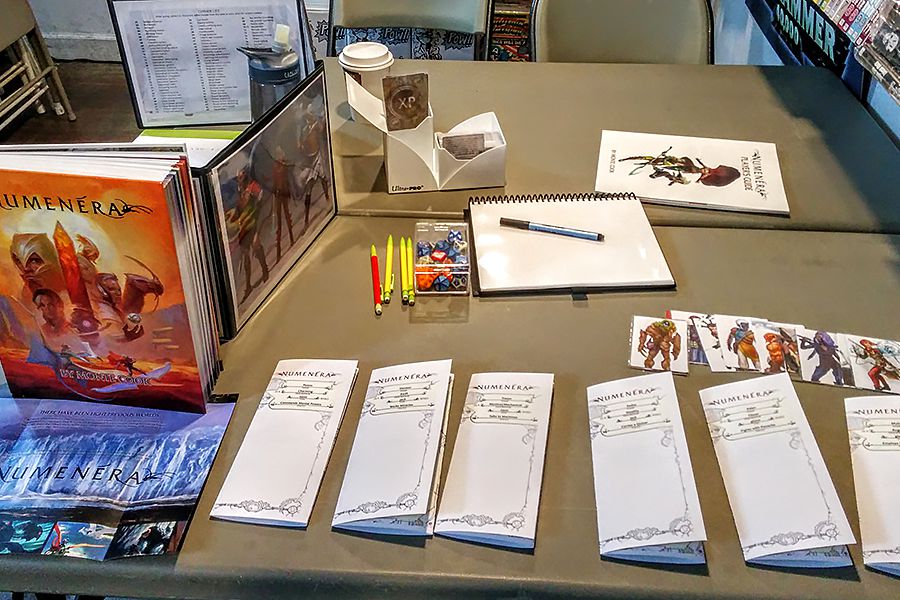Player Perspectives is a regular column penned by guest writers—players of Numenera, The Strange, and the Cypher System.
Hi! I’m Darcy Ross, an Asset Team member and all-around big fan of Monte Cook Games. I mostly run one-shots rather than campaigns, and I find the format’s constraints challenging and exhilarating, especially with strangers. I’m here to share some advice on running in-person Cypher System one-shots, perhaps to sell your home group on the system, to run a convention game, or to demo the system at your FLGS.
Rather than GM advice per se, I’m going to focus on three elements of the one-shot format that can be optimized to yield a better (and easier-run) game: establishing a comfortable atmosphere for your players; introducing the Cypher System efficiently; and bringing the tools that make your job easier but won’t break your back when you lug them around on public transit.
Tap into your Inner Spinner
For my first convention game (at Gen Con 2014), I was insanely nervous GMing for strangers. I tried to pretend to be at ease, until I actually started to become at ease, cracking jokes and turning the focus onto my players. I wrote down their names and asked about each player’s familiarity with the system and RPGs in general.
This chit-chat before the game starts helps break the ice between the strangers and gives me important information about where each player is coming from. If all my players are new to RPGs, I might need to help them understand what kinds of things are even possible (in my experience, new gamers totally rock the Cypher System). If my players have D&D experience, I tell them that Tier 1 Cypher System characters are far more competent and hardy than, say, a 1st level wizard from AD&D 2e.

It’s really important for me to get all the players contributing to the story, which often involves bringing quiet players voices out and acknowledging but not letting loud voices dominate. If the players have already started chatting with each other, it’s a little easier for them to feel comfortable speaking up and roleplaying.
On that note, this is a good time to bring up any uncomfortable topics your adventure might introduce (issues like extreme violence, gore, slavery, and so on.). If you want to be on the safe side, John Stavropoulos has a neat tool called the “X-Card” that you can use for a judgement-free way for a player or the GM to indicate they’re uncomfortable with what’s happening, and you can shift the story around it. Even if you don’t use the X-Card, I’ve found the best games come from carefully watching players to see what they are interested in or disinterested in and shaping the story around that. They’ll give you narrative threads to pull on, and it makes the story so much better when you can tailor it to them.
Welcome to the Cypher System
You can get away with surprising little up-front rules explanation in the Cypher System! This feature of the system is great for one-shots because you are often time-constrained. John Harness and I ran 30-45 minute demos of Numenera at the Adler Planetarium this year for many people who didn’t know what RPGs were—that’s an excellent testament to the system.

I find it useful to bring up the setting first, wrapping the audience up in the exciting world they’re about to step into. For Numenera, this includes sweeping gestures as I explain that we’re on Earth, a billion years in the future! Eight great civilizations have risen to enormous technological prowess, only to be fall asunder, leave, or perhaps “ascend.” And so on.
The setting introduction operates like a theatrical moment where you, the narrator, directly address the audience to invite them into an experience of shared fiction. I like to have it fairly rehearsed, because as much as it is a moment to set the magic, it is also speckled with information that they need to know because their characters would know. I once got through an hour of a Numenera one-shot and was asked “So what exactly is numenera?” Now I mention that “numenera” is the Ninth Worlder’s term for a tiny golden beetle that sings in an unknown tongue (an oddity), a salvaged power source that now functions as a bomb (a cypher), and a giant floating obelisk (a numenera discovery). As you run more one-shots, you can refine this introduction to include the most vital concepts for your game. Feel free to check out my Numenera introduction in this clip from the One Shot Podcast.
Players are usually eager to get a look at the character sheets by this time, so I explain Types, Descriptors, and Foci and let them start perusing the pregenerated characters. While they read, I launch into “Getting Things Done in the Cypher System.” I explain the Difficulty scale and how that translates to the die roll. I give a concrete example like climbing a cliff, and explain that for someone trained in Climbing, it’s effectively a Difficulty level lower for them. I go on to say that your interest in successfully climbing that same cliff might be higher if you’re being chased by an angry qephilim, and you might be inclined to apply some Effort to have a greater chance of success. Explaining Effort leads me to talking about stat Pools and how they act both as your health and an expendable resource, with a discount represented as Edge.
At this point, I orient them directly to their character sheet, pointing at the different sections and explaining cyphers, skills, and various abilities. I find it’s really important to show players spatially where all of this is, as they have likely never seen character sheets like these and may miss important information. Personally, I make and print a cheat sheet for each character with the text of each of their abilities on it for quick reference, but having a Player’s Guide or two at the table will also do the trick.
I save recovery rolls, XP, Armor, and other rules for introducing as we go. It’s easy to spend a long time talking about the setting and rules, but players will understand it all better when they have the context of the adventure to see it all in action. Plus, they came to the table to play, so I think it’s important that I deliver as much of the fun part as I can, as fast as I can. There’s always time to gush about your favorite mechanic or artwork or creature after the game!
Tools of the Trade
Here I summarize the tools, props, and Show ’Ems I typically bring to one-shots. To be honest, the game runs just fine as long as you have dice (or a dice-roller app!), character sheets, and a decent memory of the rules. I like the bells and whistles because they help me keep my games weird, get the players immersed in the art, and make me feel more prepared, which was a huge benefit when I was just starting out as a GM. Here’s what’s in my go-bag when I demo games:
- Pregenerated Character Sheets
- Character Cheat Sheets: I make these to accompany the pregenerated characters I’ll use. These documents contain explanations of character abilities, but can be substituted by a few Player’s Guides and Corebook for reference, or a pdf.
- Printed Copy of the Adventure: I run almost exclusively pre-written adventures, but they tend to be flexible enough to make my own these days (especially the Instant Adventure format!).
- XP Deck
- Cypher Deck Selection: I never game without these! However, I’ve had to remove one Numenera cypher from my deck for the (hilarious and wonderful) trouble it’s caused – Summoning Device from Cypher Deck 2. See my One Shot Podcast episodes and both my Hideous Game sessions at Gen Con. I may have to frame it at this point.
- Creature Deck Selection: I pick out the cards of any creatures that are planned for the one-shot as well as a handful that I think would fit for a spur-of-the-moment encounter. Further, I always have a Philethis on hand. They can fit into any adventure and make it creepier in an instant.
- Character Name Cards: Either printed out or written on index cards with a sharpie in a pinch.
- Essentials: Dice, pencils, something to write on (index cards, paper, whiteboard)
- Corebook, a supplemental book: I like to show off the amazing and diverse art of MCG printed products, and players often like to flip through them. The Art Book from the Exclusive Numenera Box Set Edition is also great for this purpose, and light-weight!
- Ultra Pro Dual Deck Box – There are lots of different solutions for card storage, but this is my favorite one for all the travel I do with my go-kit around Chicago. This deck box comfortably holds my penny sleeved cards (up to 60 in each slot) and comes with card dividers. I typically fit my card selections in one slot and a small dice bag in the other slot, holding everything but the pencils, paper, and books.
Other tools that are helpful but I often leave out include the Playmat, Poster Maps, GM Screen, and printed out Character Portraits from the back of Numenera Character Options or In Translation, and put in penny sleeves (for fun). I haven’t used the Weird Deck for Numenera yet, but I often find myself wishing I could think of something weird about a given location, so this deck might end up in my deck box someday!
